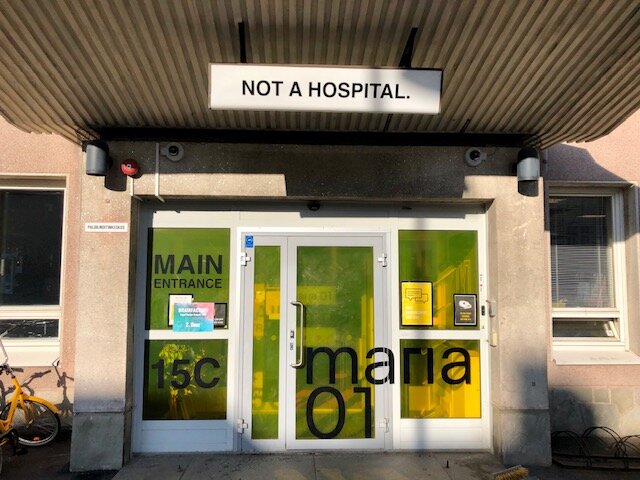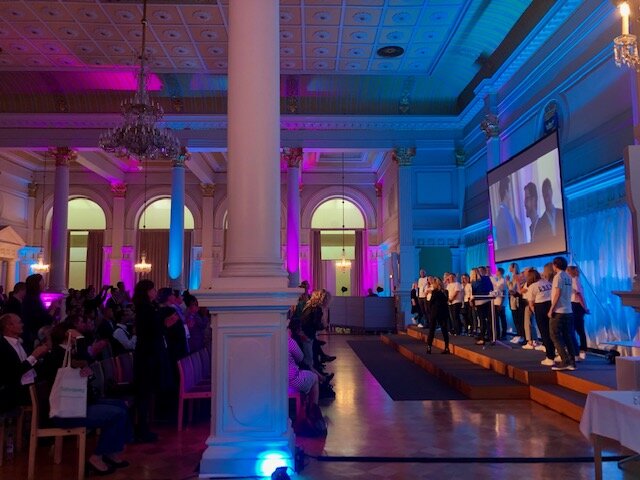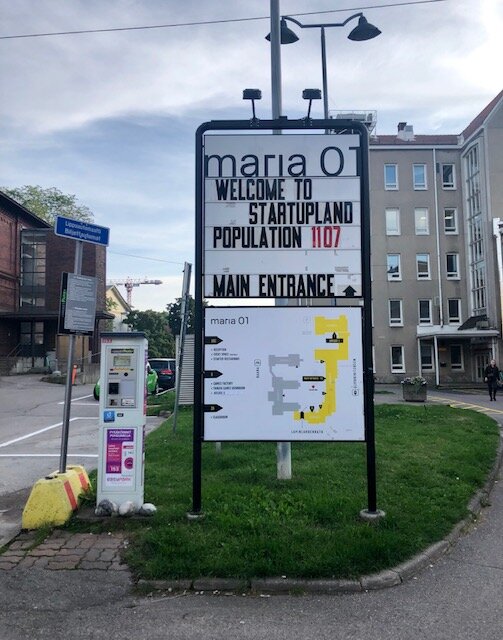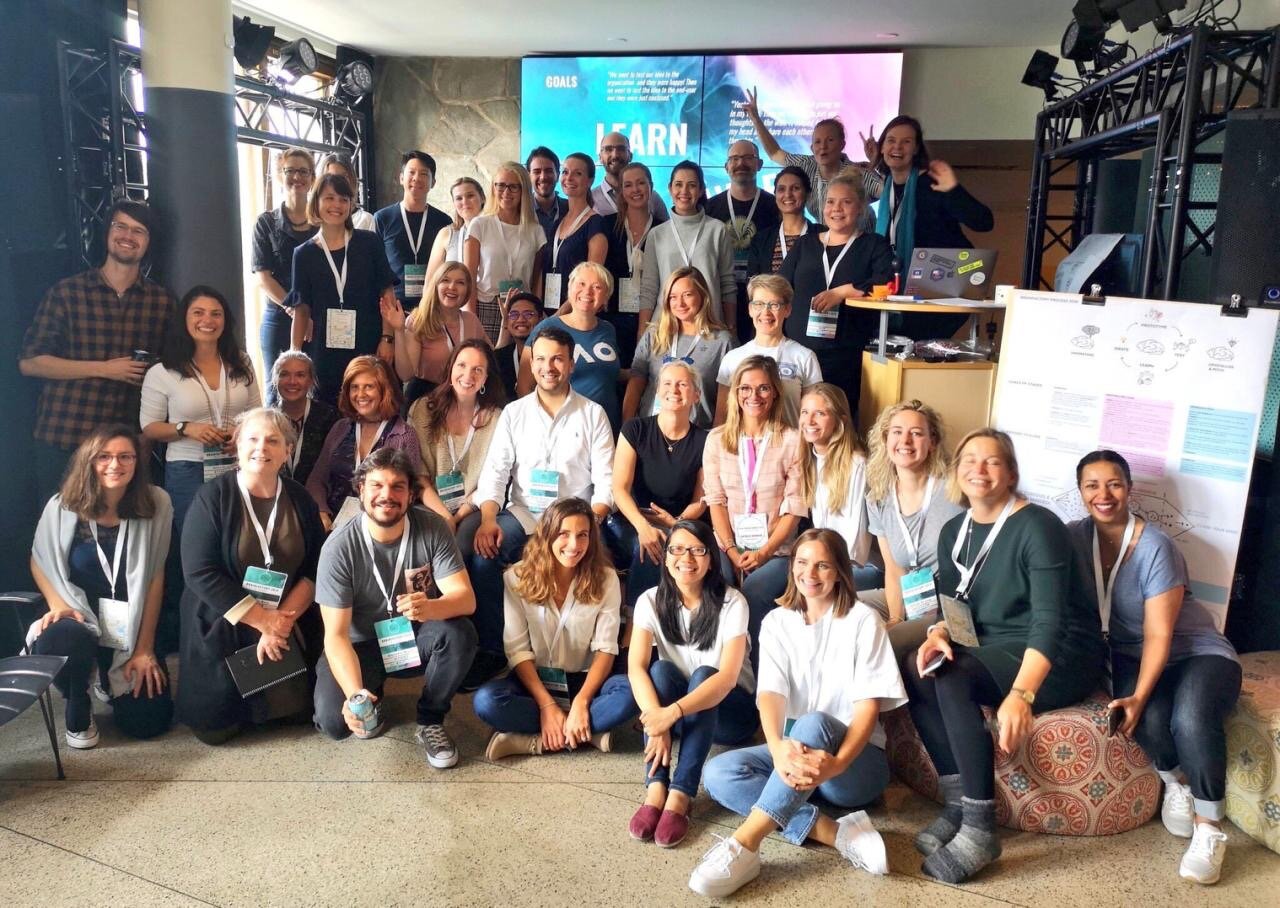WHAT’S HAPPENING – in Helsinki, Finland: The Brainfactory Workshop and Legal Design Summit
If you have been paying attention to #LawTwitter or LinkedIn recently, you will have noticed a lot of people posting from Helsinki, Finland about legal design.
That is because this past week drew an enthusiastic group of intrepid travelers from all over the world to Helsinki to participate in Brainfactory, a legal design workshop that takes place over three days, and to attend the Legal Design Summit (LDS), a one-day conference with 600 attendees including design thinking luminaries such as Margaret Hagan from the Legal Design Lab at Stanford and Dan Jackson from NuLawLab.
Brainfactory
Brainfactory, like LDS, was born in 2017, skipped a year in 2018 (the organizers call it their ‘gap year’), and returned this year. To take part in Brainfactory, you must be registered for LDS – which was no small feat this year, as the event sold out in a day and a half - apply, and be selected. Participants from 2017 rave about it – some say participating literally changed the course of their lives. By a bizarre twist of fate and a random series of events I was able to apply for Brainfactory this year and fortunate enough to be selected as one of the participants.
So what is Brainfactory and what makes it so remarkable?
First of all, Brainfactory is free as long as you can make it to Helsinki and put yourself up. This year, the organizers of LDS under the helm of CEO Pilvi Alopaeus turned the organization into a nonprofit, with attendance to both Brainfactory and LDS free of charge, relying on sponsorship to pull it all together. Given the number of attendees at LDS, and the quality of venues and organization for both events, this was quite an achievement.
In essence, Brainfactory is a three day legal design workshop, with 35 participants divided into 8 teams of four or five people who learn in 44 hours how to use service design methodology to solve real world legal problems. Most people invited to attend Brainfactory this year were sent by their law firms or organizations to learn the technique of legal design and bring it back to use with their teams and clients. Each team was mentored by a design professional who assisted and inspired the team throughout the process. My team – Team 8 - was mentored by the wonderful Cat Moon, Director of Innovation Design for the Program in Law and Innovation at Vanderbilt Law School. The other mentors included professionals from Paris, Berlin, and across the United States, and Brainfactory participants also benefited from feedback provided throughout the workshop from board members and local Nordic service design experts drawn from various legal and non-legal organizations.
We arrived at the venue at five o’clock on Tuesday evening. Maria 01 is a “campus” for Nordic start-ups, and has exactly the kind of quirky touches you’d expect, including a surprisingly good restaurant called “Starter”, where lunch was provided each day. My hotel provided guests with bicycles to use during our stay, so I arrived at Maria 01 by bike and felt like a real local. But for anyone expecting a cruisy European junket, this was not it. Once Brainfactory got started, it was intense. The first night teams met each other, received a brief summary of the problem they would be solving, and heard some inspirational opening speeches by the Brainfactory organizers and from Cat Moon. Then each team met in-person with their client, to hear more about the problem and dig deeper into it. We didn’t leave the venue until after 10pm, and so I rode back to my hotel in the dark, buoyed by a cool sea breeze and feeling immensely inspired.
The next two days were similarly concentrated, starting at 9am sharp and lasting into the evening and beyond – on day two when our team had finally set aside our problem for the night, another team was still busy brainstorming at the table next to us in the bar we retired to after dinner. Each day started with an educational talk from an expert. On Wednesday, our ideation and prototyping day, we learned about LEGO Serious Play from Emma Jelley, formerly European Head of Legal at Google, who now runs her own design consultancy in Finland. On Thursday, we learned about storification from Anna Kalliomaki, the founder of story design agency Tarinakone, and used a story tree technique to build the framework for our client presentation.
The workshop was structured and organized, with teaching moments and practical design tools introduced and interspersed between the many hours of hands-on design work. The interdisciplinary teams were made up of people across 18 countries including all the Nordics, the United States, Canada, the UK, France, Germany, Italy, the Netherlands, the Czech Republic, Columbia, New Zealand and Thailand. In the room we had students, innovation professionals, administrative chiefs, practicing lawyers. My team included an innovation manager from Sheffield, England, the administrative chief of a district court in Sweden, a practicing lawyer working in-house in Amsterdam, and a student from Finland who is studying law in Sweden and heads up the Stockholm chapter of Legal Hackers. One of the special things about Brainfactory is how it confirms in practice the benefit to the creative process of diversity in teams. Another is how close the teams became. By day 2 our team had bonded tightly and were swapping in-jokes on social media.
The clients who provided the problems for Brainfactory included Ilves, a Finnish legal technology provider with a solution that brings data together from all systems of a firm or organization; Fondia, a forward-thinking Finnish legal services provider; and the Finnish Ministry of Environment, with a problem around fair principles and regulation for the ownership and development of lake-front cottages in Finland. After meeting key stakeholders from our clients on the first evening, most teams visited their clients on-site at their offices to test early prototypes on day 2. On the afternoon of day 3, the clients were back at Maria 01 to hear the three minute presentations their teams had prepared. The close involvement between teams and clients taught participants how critical it is to truly put the user at the heart of a solution, to interview and understand a problem from the user perspective, to test and iterate and test again. Many of us who were involved in Brainfactory will stay in touch both with our fellow team members and with our clients, for follow-up discussions. I for one have come away with new tools and a deeper understanding of service design in practice, and insights that I will share with my firm and team members. I have also come away with new friends, invaluable contacts, and an experience I will never forget. I can understand why some people have called Brainfactory a game-changer, and I wholeheartedly recommend it to anyone with an interest in learning more about design thinking.
Legal Design Summit
After 44 intense hours of problem-solving, Brainfactory participants said a last goodbye to Maria 01 and dispersed to attend various LDS side events or pre-parties across Helsinki, only to gather again the next day with the hundreds of people who had flown in to Helsinki for the conference.
LDS, held in a stunning room in Helsinki City Hall, right by the harbor, was split into three two-hour sessions over the course of the day: Legal Design from Thinking to Doing, Transforming Strategies (into a Culture), and Legal Design Impact and Beyond – What’s Next? As with all conferences, some sessions were more inspiring or educational than others but the day as a whole was certainly worth the trip for those who made it to Helsinki just for LDS. A few highlights included:
Inspirational
Dan Jackson reminding us all that law as a concept was perhaps the most creative idea that human beings have ever come up with. Because it has developed through slow deliberation, it’s easy to forget that this was once a radical idea. Bringing creativity back to the way we think about law is not therefore antithetical to its origins.
Self-styled legal provocateur Cat Moon calling on all of us to help fix a failing legal profession by adopting the mindsets that have been proven to be most valuable in innovation leaders, and pointing out that those mindsets happen to coincide with the principles of human-centred design. They are the mindsets of empathy, embracing ambiguity, experimentation, acceptance of failure, radical collaboration, and insane - yet humble - curiosity.
Margaret Hagan discussing the rise of legal design across the world and telling us that she is kept up at night by the thought that all of these projects would be more effective if we were working together. Margaret calls on all of us to create strategic blueprints for legal design, creating communities of people globally who are tackling similar problems, sharing research, patterns, metrics, user experiences and thereby developing a bigger, more powerful understanding of the problem, and of the most promising solution ideas. Let’s get over the “patting ourselves on the back for doing design” mentality, stop creating silos, and instead build a global network leadership model.
Practical
Marco Imperiale providing a shopping list of all the reasons firms reject innovation initiatives, and suggesting business-driven arguments to counter them. Key amongst these: For firms who cite “it’s not a priority” – the opposing argument is that the best firms are always ready to change to meet new market demands. For firms that reject design thinking because “we are a serious law firm” – the opposing argument is that serious does not equal professional. Serious can equal boring, staid, old-fashioned. And professional can mean forward-thinking. For firms who assume clients would not appreciate money spent on these kinds of efforts – the opposing argument is: have we actually asked them? Do we know what the client wants? Put the client first.
Michael Doherty of Lancashire Law School defining legal design as a culture clash between two communities, the legal community and the design community, and suggesting that communication between these must be a two-way street, a cultural exchange. Service design can act as the glue in a multi-disciplinary team, but before success is achieved, an effort must be made to establish modes of communication across the legal and design cultures.
Success Stories
So inspiring to hear stories from three different countries (Sweden, the United States and Columbia) of courts that are innovating using service design methods to make justice more broadly available to people. Andrea Lindstrom, chief administrator of Helsingborg District Court in Sweden and the Court’s Chief Judge, Ylva Norling Jonsson talking about creating social media channels so that people can more easily contact and ask questions of the Court registry, and altering court process after a design exercise responding to actual first-hand feedback from the community. Santiago Pardo Rodriguez of the Legal Design Lab at the University of Andes showing a video – set to the Imperial March from Star Wars – of the acres of paper that are generated each day in the court system in Columbia, and how service design methods have given rise to new processes that will manage and control this. Stacy Butler, the Director of Innovation for Justice at the University of Arizona, speaking about running a design project with a court that engaged the victims of domestic abuse and created a gallery of experiences with which the community could interact, to bring deep understanding and awareness of a cause.
Marie Patel-Saville, the founder and CEO of Amurabi, was a Brainfactory participant in 2017 who returned to Paris afterwards, quit her in-house legal job and started her own consultancy. She now uses legal design to develop solutions for genuinely effective compliance programs in areas such as money-laundering and anti-corruption. Notable and fascinating was the brief lesson Marie gave us in the use of neuroscience to enhance the effectiveness of design methodology. I heard many designers afterwards speaking about how they were inspired to learn more about this as part of their practice.
Hallie Jay Pope from the Graphic Advocacy Project in Brooklyn New York, showing how she uses legal design and visual communication tools to build community power. Hallie showed us real examples of the cartoons she taught herself (extremely effectively!) to draw, which encourage people who risk remaining ignorant of their legal rights to read about them and understand when and how to avail themselves of legal protections. One of these was a Know-Your-Rights resource about ICE and law enforcement, which has been so successful that on a recent raid in areas of distribution very few people were picked up because they knew to ask for warrants or otherwise avail themselves of legal protection.
Over the course of the day I saw 3 or 4 examples of legal documents that had been re-designed using service design methods. Particularly interesting is the fact that all of these had in common: visual design elements, the elimination of fine print, signposts to differentiate sections of a document, and educational information built in to the document to explain to readers along the way why the information they are providing is relevant and important. It showed that the future of law and legal documents may look very different to the staid contracts we have become so accustomed to.
Dan Jackson of NuLawLab, and Meera Klemola and Emma Hertzberg from Observ Design Agency, took us on journeys of legal design around the world, revealing stories of actual design efforts in various countries. In Europe, the UK and Australia, these stories are more common. In the United States, there are successes but largely confined to academic institutions and access to justice programs.
I often find with conferences that much of the value comes from discussions had on the periphery of the actual talks, and LDS was no different. In the hallways, over coffee, at the tremendous after-party hosted by Finnish law firm Dottir, I met in-house legal ops people from Nike in Amsterdam and Airbus in Munich, both of whom had interesting success stories to tell of using service design within their teams. I also met and spoke with legal and other service designers from Germany, the Netherlands, Belgium, France, Columbia and the UK. And I met many people from across the world who have jobs like mine, trying to drive innovation initiatives in large law. It’s hardly surprising to note that we are all facing similar obstacles.
If there was a theme from LDS it would be “to do nothing is to go backwards” (vocalized by Ylva Norling Jonsson, but relevant to all of the discussions of the day), and a sense that though design in legal has come far in the past six or so years, there is a lot more work still to be done, and more opportunities to be gained and headway to be made in this field. As I learned from Brainfactory, true service design requires hard work, and real buy-in from clients and teams alike. Many of us are still in the process of building that buy-in. Design thinking and its application to law is one area in which the public sector has made greater strides than the private sector.
My sense is that this field of legal design – or service design in legal – is just now gaining true momentum. Certainly in the United States, it has a long way to go before it takes hold in law firms and corporate legal departments as a recognized and accepted practice of innovation and problem-solving. It will be interesting to see whether, in another six years, it is entrenched in law as it is in other industries.







